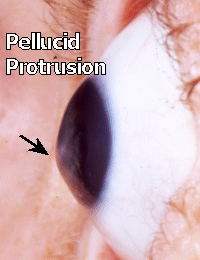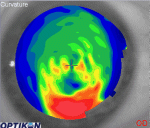Pellucids Marginal Degeneration, a disease in many ways similar to Keratoconus, really exists largely in obscurity. Lack of diagnosis and misdiagnosis are still the unfortunate norm for this condition.

Pellucids Marginal Degeneration is a sub-category of keratoconus. This condition typically affects both eyes although one eye is usually a bit worse than the other eye. It also tends to appear between the ages of 20 and 40. The main difference between Pellucids Marginal Degeneration and Keratoconus is that the cornea thins in the area from the center of the pupil all the way down to the bottom of the cornea. Due to this large area of thinning, Pellucids corneas involve a larger distorted geographic area usually extending from the inferior corneal margins up to the center of the cornea. It is not unusual for 50% or more of the corneal surface to be involved. Because so much of the cornea can be affected, fitting this type of cornea can be more challenging. The problem we face as eyecare practitioners is fitting the steep areas of the cornea without adversely affecting the flatter areas. All this must be accomplished while providing clear and stable vision along with a comfortable lens to wear.
 |
 |
 |
| Patient #1 (A.S.) | Patient #2 (C.Z.) | Patient #3 (D.B.) |
Above are three different (from three different patients), yet typical topography mappings of Pellucids corneas. The description of a Pellucids cornea has been likened to "2 doves kissing" or the "lobster claw" or a "handlebar moustache." This is refering to the red areas on the topographical mapping which correspond to the areas of steepening. I chose the three patients above because each is wearing a different "modality" of contact lens, yet all are successful. They illustrate that there is not a single type of lens that addresses this condition but rather each cornea must be fit based on its own merits and requirements. Patient #1 is in a "piggyback system," using a disposable soft lens with a custom designed small diameter gas permeable Z-Wave lens "piggybacked" on top. Patient #2 is wearing a topography guided custom scleral Z-Wave gas permeable lens. Patient #3 is wearing a Z-Wave corneal large diameter gas permeable lens. All three patients are able to wear their lenses for the entire day very comfortably while achieving visual acuity slightly better than 20/20.
Although Pellucids Marginal Degeneration can have an enormously negative impact on vision, and glasses often do not correct the visual distortions very well, the proper contact lens modality can really restore a very normal quality of vision.
